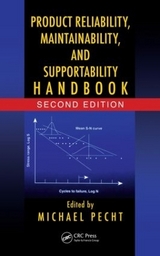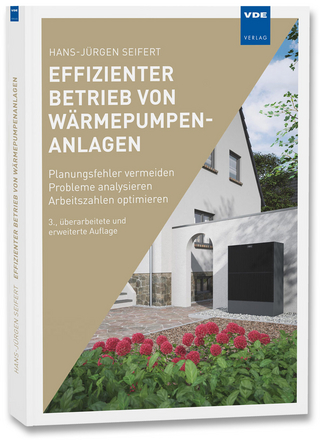
Product Reliability, Maintainability, and Supportability Handbook
Crc Press Inc (Verlag)
978-0-8493-9457-7 (ISBN)
- Titel erscheint in neuer Auflage
- Artikel merken
This unique publication addresses the role of reliability, maintainability, and supportability in the life-cycle of a product, in the context of product effectiveness and worth. It emphasizes all aspects of producing an effective electrical or mechanical system. This is the only handbook available on this subject and the only book that is this comprehensive and informative.
The Product Reliability, Maintainability, and Supportability Handbook examines the logistics, cost, and the physics of failure-topics never before found in a single volume on reliability. It describes the factors that affect product effectiveness and worth: performance, reliability, design effectiveness and margin for error, availability, affordability, use effectiveness, and logistic effectiveness. The handbook contains 13 in-depth chapters, opening with an introduction on product effectiveness and worth and concluding with reliability and maintainability data that can be combined with performance data to assess overall effectiveness of the product. The pages are filled with valuable information that can be easily and quickly put to practical use.
Basic principles of the mathematical theory of probability and necessary background are provided. Concepts and basic theory of reliability in terms of probability and statistical inference are also given. Techniques for deriving probabilistic models from observational data as well as reliability models and associated validation techniques are detailed. Software and software reliability, quality, and safety are all covered, including the development life-cycle process and mechanisms by which software errors are introduced.
The book presents design guidelines and techniques and the requirements for materials, manufacturing, and assembly. Learn how to analyze the reliability of redundant and fault-tolerant products. Use the methods for modeling and analyzing failures of repairable products that normally exhibit wearout characteristics. The Product Reliability, Maintainability, and Supportability Handbook also provides reliability improvement techniques to improve the competitiveness of existing products.
The book includes helpful summaries and numerous problem sections to reinforce and test learned information. This reference source is the guide that professionals and technical managers should turn to when they need a comprehensive and detailed overview of everything that goes into producing systems and products that meet customer needs in an effective and timely manner.
PRODUCT EFFECTIVENESS AND WORTH
Product Attributes
Programmatic Factors
Product Effectiveness Factors
Operational Availability
Design, Use, and Logistic Effectiveness
Design Effectiveness.. Use Effectiveness. Logistic Effectiveness
Reliability
Mission Reliability. Logistic Reliability
Restoration
Maintainability
Time Elements and Product Effectiveness
Relationships among Time Intervals
Assigning Responsibility
Integrated Product and Process Development
Managing Product Effectiveness
Summary
PROBABILITY CONCEPTS
Random Events
Definitions of Probability
Basic Theorems of Probability
Conditional Probability and Multiplication Rule. Statistical Independence. Total Probability Theorem. Bayes' Theorem
Random Variables and Their Distributions
Random Variables
Probability Distribution
Main Descriptors of a Random Variable
Mean. Variance and Standard Deviation. Markov Inequality. Chebyshev Inequality. Skewness. Quantiles and Percentiles
Brief Review of Distributions
Discrete Distributions. Continuous Distributions
Multiple Random Variables
Joint Probability. Conditional Probability Distributions
Covariance and Correlation
Functions of Random Variables
Probability Distributions
Main Descriptors of Random Functions
Random Processes
Definition of a Random Process
Main Descriptors of Random Process
Mean Value. Variance
Stationary Random Processes
Ergodicity of Random Processes
Counting Processes
Recurrent Point Processes
Markov Process
Some Limit Results in Probability and Stochastic Processes
Limit Theorems in Probability Theory
The Central Limit Theorem. The Poisson Theorem. A Random Number of Random Variables in a Sum
Stochastic Processes
Crossing a "High Level" by Continuous Process. Thinning a Point Process
The Superposition of Point Processes
STATISTICAL INFERENCE CONCEPTS
Statistical Estimation
Point Estimation
Method of Moments. Method of Maximum Likelihood
Interval Estimation
Hypothesis Testing
Frequency Histogram
Goodness-of-Fit Tests
The Chi-Square Test. The Kolmogorov-Smirnov Test. Sample Comparison
Reliability Regression Model Fitting
Gauss-Markov Theorem and Linear Regression
Regression Analysis. The Gauss-Markov Theorem. Multiple Linear Regression
Proportional Hazard (PH) and Accelerated Life (AL) Models
Accelerated Life (AL) Model. Proportional Hazard (PH) Model
Accelerated Life Regression for Constant Stress
Accelerated Life Regression for Time-Dependent Stress
PRACTICAL RELIABILITY CONCEPTS
Reliability Measures
Time-to-Failure Distribution and Reliability Function
Mean Time to Failure and Percentile Life
Failure Rate and Cumulative Hazard Function
Life Distributions as Reliability Models
Geometric Distribution
The Binomial Distribution
Exponential Distribution
Classes of Distribution Functions Based on Aging
Failure Rate and the Notion of Aging. Bounds on Reliability for Aging Distributions. Inequality for Coefficient of Variation. Cumulative Damage Model
The Weibull-Gnedenko Distribution
The Normal Distribution
The Logarithmic Normal Distribution
Parametric and Nonparametric Distribution Estimation
Statistical Data in Reliability
Parametric Estimation
The Exponential Distribution. The Weibull-Gnedenko Distribution
Nonparametric Distribution Estimation
Distribution Function Estimation. Percentile Life Estimation for Continuous Distributions. Percentile Life Estimation for Aging Distributions
HARDWARE RELIABILITY
Failure Mechanisms and Damage Models
Mechanical Design Failures
Thermal Design Failures
Electrical Design Failures
Electromagnetic Interference. Particle Radiation
Yield
Buckling
Fracture
Interfacial De-Adhesion
Fatigue
Creep
Wear
Aging due to Interdifussion
Aging due to Particle Radiation
Other Forms of Aging
Corrosion
Metal Migration
Loadings, Stresses, and Material Behavior
Variabilities and Reliability
Reliability Prediction Techniques
Case Study: Wire Bond Assembly in Microelectronic Packages
Failure Mechanisms and Stress Analysis
Wire Flexure. Shear of Bond Pad. Shear of Wire and Substrate. Axial Tension of Wire
Stochastic Modeling of Variabilities and Reliability
Fatigue Lifetime and Reliability Prediction
Qualification and Accelerated Testing
Derating and Logistic Implication
Manufacturing Issues
Process Qualification
Manufacturability, Process Variabilities, Defects, and Yields
Screening and Statistical Process Control
Summary
Software Reliability
Definitions
Software Development: The Classic Waterfall Life-Cycle
Full Description
Software Requirements Analysis Phase. Preliminary and Detailed Design Phases. Code and Unit Test Phase. Integration and Product Testing. Acceptance Testing. Maintenance and Operations. Retirement
Distribution of Errors over the Development Life-Cycle and Related Costs
Techniques to Improve Software Reliability
Designing Reliable Software
Structured Programming. Design Techniques. Design Issues
Designing Fault-Tolerant Software
Recovery-Block Design. N-Version Programming. Consensus Recovery Block
Testing
Black Box and White Box Testing. Module Testing: White-Box and Black-Box Testing Strategies. Integration Testing
Formal Methods [Neuhold and Paul, 1991]
Formal Specification Methods. Formal Verification
Developing of a Process Infrastructure for Effective Software Development
Techniques to Assess Software Reliability
Software Analysis Methods
Failure Mode and Effect Analysis (FMEA). Fault-Tree Analysis
Software Metrics
Requirements Measures: The Specification Completeness Measure. Design Phase Measures. Code and Unit Test Phase Measure: Defect Density [IEEE, 1989a]
Software Reliability Models
A Classification of Software Reliability Models. Jelinski and Moranda's Model [1972]. Musa Basic Execution Time Model (BETM) [1975]. Musa-Okumoto Logarithmic Poisson Execution Time Model. Mills Fault Seeding Model [IEEE, 1989b]. Nelson's Input-Based Domain Model. Derived Software Reliability Models. A Critique of Existing Software Reliability Models
Conclusions
MAINTAINABILITY CONCEPTS AND ANALYSES
Measures of Maintainability
Establishing Maintainability Requirements
Elements of the Maintainability Program
The Maintainability Program Plan
Modeling the Maintainability Design
Designing for Serviceability
Designing for Supportability
Designing for Maintainability
Testability
Testability Measures. Testability Analysis
Hardware and Construction
Accessibility and Fasteners. Packaging and Connectors
Maintainability Verification Testing
Objective
General Procedure
Test Planning
Test Index
Test of the Mean, Lognormal Assumption
Preventive Maintenance Scheduling
Testability Problem
DESIGNING FOR RELIABILITY
Requirements
The Life Cycle Usage Environment
Characterization of Materials, Parts, and the Manufacturing Processes
Design Guidelines and Techniques
Preferred Parts
Redundancy
Protective Architectures
Stress Margins
Derating
Size and Weight Control
Potential Failure Sites and Failure Mechanisms
Catastrophic Failure. Intermittent Failures. Out-of-Tolerance Failures. Maladjustment Failures
Designing for Operability
Designing for the Environment
Temperature Control
Shock and Vibration Control
Chemical Actions Control
Biological Growths Control
Moisture Control
Sand and Dust Protection
Explosion Control
Electromagnetic Radiation Control
Nuclear Radiation Control
High Vacuum Control
Human Factors
Designing for Maintainability
Design Reviews and Reliability Controls
Preliminary Design Review
Detailed Analysis Review
Final Design Review
Test Correlation Review
Summary
RELIABILITY ANALYSIS OF REDUNDANT AND FAULT-TOLERANT PRODUCTS
Static Redundancy-Combinatorial Modeling
Simple Redundancy
Series Connections. Parallel Connections
Series-Parallel Connections. Non-Series-Parallel Connections
Masking Redundancy
Triple Modular Redundancy. N-Modular Redundancy
Fault Trees
Cutset Generation. Inclusion/Exclusion Method
Time Dependence
Mean Time to Failure
Hazard Rate
Dynamic Redundancy-Markov Modeling
Standby Sparing
TMR/Simplex Product
Repairable Products
Independent Repair. Dependent Repair
Dependent Failures
Common-Mode Failures
Dependent Failure Rate
Multi-Mode Failures
Coverage Modeling for Fault-Tolerant Computer Product
Terminology
The Impact of Imperfect Coverage
Some Coverage Models
General Structure of a Coverage Model
Near-Coincident Faults
Including the Coverage Model in the Product Model
Bounded Approximate Models
Truncated Exhaustive State Enumeration
Truncated Sum of Disjoint Products
Truncating a Markov Chain
Advanced Topics
Combining Performance with Reliability
Phased Applications
Advanced Fault-Tree Modeling
Summary and Conclusions
RELIABILITY MODELS AND DATA ANALYSIS FOR REPAIRABLE PRODUCTS
Analytical Background
Age-Independent F-R Processes
Age-Persistent F-R Processes
Defining Characteristics of AI and AP Processes
Failure Repair as Renewal and Poisson Processes
Renewal Processes. Homogeneous Poisson Processes. Non-Homogeneous Poisson Processes. Failure-Repair Process Relationships
Data Analysis Techniques
Graphical Trend Tests
Test for a Renewal Process
Test for a Homogeneous Poisson Process
Comparison of Two Samples
Fitting the Weibull Non-Homogeneous Poisson Process
Weibull Process Characteristics. Estimation of l and b. Goodness-of-Fit Tests. Confidence Interval Estimates
CONTINUOUS RELIABILITY IMPROVEMENT
Reliability Growth Process
Reliability Improvement Program
Failure Classification
Test Optimatization
Test Cycles and Environmental Considerations
Stress Margin Testing
Stressed Life Test (STRIFE)
Highly Accelerated Life Test (HALT)
Inverse Power Law Model and Miner's Rule
Continuous Growth Monitoring
Continuous Growth Models
Duane Model. AMSAA Model
Discrete Models
Lloyd and Lipow Model. Wolman Model
Reliability Improvement Effectiveness and Uncertainty
Reliability Improvement Effectiveness
Reliability Improvement Uncertainty
LOGISTICS SUPPORT
Logistics Elements
Influence of Reliability on Logistics Resources
Reliability, Maintenance Rates, and the Expected Demand for Logistics Resources
False Alarm Rate (FAR). Cannot Duplicate Rate (CND). Probability of Fault Detection. Probability of Fault Isolation. Maintenance Action Rate. Demand Rate. Mean Downtime
Supply Support-Provisioning of Repair Parts and Consumables
Optimal Reorder Quantity. Spares Availability and Provisioning. Provisioning a Product Composed of Replaceable Parts. Spares Optimization
Manpower and Personnel-Manning Levels
Support Product-Utilization and Productivity
Repair Level Analysis
Summary
PRODUCT EFFECTIVENESS AND COST ANALYSIS
A Framework for Product Effectiveness Quantification using Markov Processes
A Generalization of the Model for Multifunction Operations
Effectiveness Evaluation Example-Continuous Performance
Model Applicability
Factors to Consider in Analyzing Product Effectiveness
Phase I: Define Application, Product, and Logistics Support
Phase II: Select Measures of Effectiveness
A Model Concept for Capability
Phase III: Develop the Mathematical Model
Phase IV: Obtain Data Inputs
Phase V: Exercise, Interpret, and Refine Model
Cost Effectiveness Analysis
Cost Categorization
Cost Estimation
Cost Adjustments
Cost Uncertainty and Cost Sensitivity
Combining Effectiveness and Cost
| Erscheint lt. Verlag | 4.5.1995 |
|---|---|
| Zusatzinfo | 693 equations; 61 Tables, black and white |
| Verlagsort | Bosa Roca |
| Sprache | englisch |
| Maße | 178 x 254 mm |
| Gewicht | 930 g |
| Einbandart | gebunden |
| Themenwelt | Technik ► Elektrotechnik / Energietechnik |
| Technik ► Maschinenbau | |
| ISBN-10 | 0-8493-9457-0 / 0849394570 |
| ISBN-13 | 978-0-8493-9457-7 / 9780849394577 |
| Zustand | Neuware |
| Informationen gemäß Produktsicherheitsverordnung (GPSR) | |
| Haben Sie eine Frage zum Produkt? |
aus dem Bereich



